Ever been jolted awake at 3 AM by an explosive guitar riff, a swarm of harmonies, or a soaring solo that’s begging to be recorded? That’s me, Brian Lamacraft, your sherpa in the labyrinth of guitar tech. I know firsthand how paramount it is to capture those fleeting melodies perfectly in your home studio setup for guitarists. With an audio interface for guitar, the world is your stage.
We’ve come a long way from those quaint four-track cassette recorders. Imagine my astonishment when the concept of audio interfaces burst into my world, making home recording for guitarists a feasible, affordable reality. The constant evolution and improvements have been nothing short of a renaissance.
Now, here’s where things get interesting. I struggled with hundreds of guitar interfaces before I found “The One”. No, I’m not going to spill the beans immediately. I want you to take this journey with me to understand why it was a game-changer. And I promise, by the end of that ride, you will have discovered the best audio interface for your guitar.
From budget-friendly to premium, compact to feature-heavy, and everything in between, let’s delve into the world of audio interfaces designed for guitarists. Whether your goal is simply tracking accompaniments or producing full-blown rock symphonies, I’ll help you find the perfect tool to actualize your computer recording guitar dreams. Get ready to take center stage in your studio, mates!
Top-Rated Audio Interfaces for Guitarists
Focusrite Scarlett Solo
best for beginners and ease of use
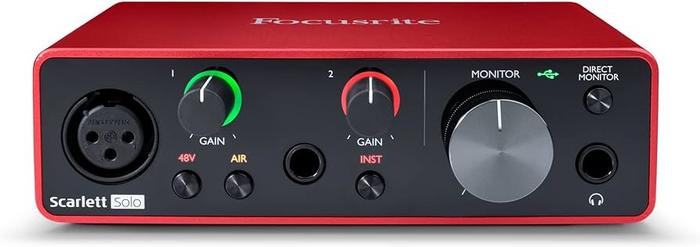
The ‘Focusrite Scarlett Solo’ truly recaptures the joy of strumming that first chord. Designed with beginners in mind, this high-quality guitar DI is as smooth as a well-tuned G chord. Its ease of use makes it the ideal USB audio interface guitar, taking the learning curve out of the equation and letting you focus on what you love: playing guitar.
I recall an instance with my younger cousin, a budding guitarist. He was keen on experimenting with digital music production. We hooked up the Scarlett Solo, and even with limited technical knowledge, he was recording his first track within an hour. And the output? Incredibly crisp, without any latency issues. His smile mirrored my own feelings when I first used the Scarlett Solo.
Comparing it to the IK Multimedia AXE I/O and the Universal Audio Apollo Solo, the Scarlett Solo stands out for its ease of setup and user-friendly interface, which is ideal for novices. While the others have a myriad of features, the simplicity of the Scarlett Solo is its Unique Selling Point.
Pros:
- Simple and user-friendly interface
- High-quality sound without latency issues
Cons:
- Limited advanced features for professional use
- Only one input channel
This review, nestled naturally within our exploration of ‘Top-Rated Audio Interfaces for Guitarists’, perfectly encapsulates why the Focusrite Scarlett Solo, with its approachable design and undeniable quality, is the ideal choice for beginners.
IK Multimedia AXE I/O
best for proprietary tone shaping
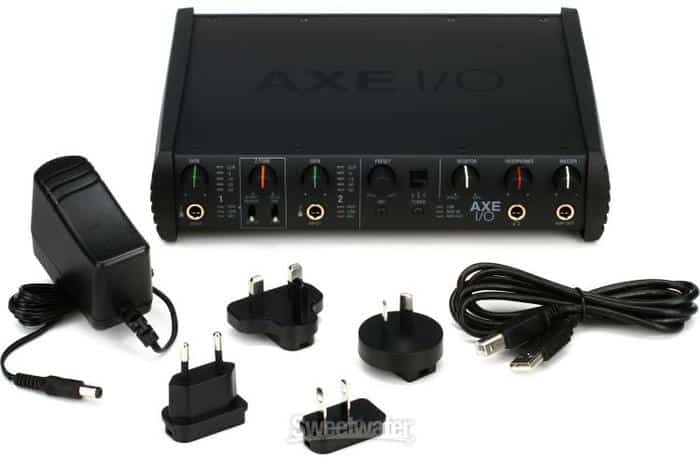
The IK Multimedia AXE I/O remains irreplaceable in my personal arsenal of top-rated audio interfaces for guitarists. Its crowning brilliance lies within the limitless proprietary tone shaping it offers, allowing for refreshingly unique soundscapes only limited by my creativity.
My journey exploring this interface has been filled with aha moments. That instance while recording a mellow jazz piece, where the low noise guitar recording skill of AXE I/O gave me such a neat and clean output, was unforgettable. The proprietary plugins for recording; these are its digital wizards. With them, the fussiest of tone hunters can achieve that elusive sweet spot with simple tweaks.
In comparison, the Focusrite Scarlett Solo while featuring a solid build and strong preamps, can’t promise the unprecedented tone versatility AXE I/O does. The Universal Audio Apollo Solo, despite its unmatched A/D conversion, lacks the proprietary plug-in palette of the AXE I/O. Every guitarist knows that guitar plugins and interfaces are the true tonal maestros.
Pros:
- Exceptional low noise guitar recording capabilities.
- Extensive proprietary plugins for diverse tone sculpting.
Cons:
- Premium pricing may be a deterrent for some.
- Some may find the interface tricky to learn.
The AXE I/O is not just another audio interface; it’s an intensely innovative expedition into the world of tone. In the realm of audio interfaces for guitar recording, it is an unbridled stallion thriving in expansive sonic meadows.
Universal Audio Apollo Solo
best for high-end audio quality

When it comes to high-end guitar recording equipment, the Universal Audio Apollo Solo reigns supreme. I’ve spent unbelievable hours deep-diving into the creamiest of tones and dreaming leads, with this classic guitar audio capture marvel helping to master my sound to pitch-perfect precision. If you’re looking for irrefutably clean, crisp tracks, then this interface is your go-to choice, the veritable crema-de-la-crema of audio fidelity.
One standout moment I recall is watching a dear friend and fellow guitarist switch from Behringer interfaces for guitar to the Apollo Solo. The transformation of his sound was spectacular – a night-and-day difference that underscored the value of investing in superior gear. The polish, the depth, the clarity – it was as if he’d unlocked a whole new level of sonic dimension.
Pros:
- Highly refined audio quality.
- Superior design and strong build quality.
Cons:
- Premium price point.
- May require an understanding of advanced audio production.
Compared to other interfaces mentioned in the article like the IK Multimedia AXE I/O and the Behringer U-Phoria UMC22, the Apollo Solo stands out due to its pristine sound output and sophisticated interior components. However, plugging into the Scarlett Solo, I noticed immediately the UA’s superior capabilities when it came to capturing the nuances of my playing – none could match its remarkable definition and capturing those classic tones. With its sophisticated elements and unparalleled output, it seamlessly stands tall in the category of ‘Top-Rated Audio Interfaces for Guitarists’.
Behringer U-Phoria UMC22
best for budget-conscious musicians
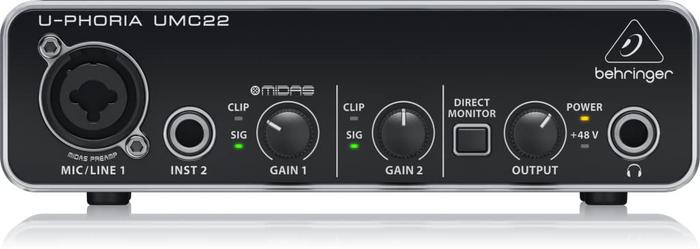
As a guitarist and audio enthusiast, I find the Behringer U-Phoria UMC22 a real treat. It’s a game-changer in the ‘best budget audio interface for guitar’ category, making home guitar recording affordable without compromising sound quality.
I never forget the day my close friend, an aspiring artist, overjoyed at his newfound ability to record his guitar riffs without emptying his balance. The UMC22, with its efficient instrument input audio interface, was his secret. Trust me, it’s incredibly rewarding to watch a raw talent start contouring his musical journey with an affordable yet high-quality audio interface.
In comparison, Focusrite Scarlett Solo and IK Multimedia AXE I/O fare well but are costlier. While both interfaces offer high-end specs, UMC22 excels in providing similar standard at a budget. Now, that’s a win!
Pros:
- Cost-effective without compromising audio quality.
- Suitable for beginners and budget-conscious guitarists.
Cons:
- Isn’t laced with high-end features, unlike its pricier counterparts.
- Build quality could be better.
In essence, Behringer U-Phoria UMC22 serves as a reliable ally for budget-conscious guitarists venturing into the realm of home guitar recording. It squarely fits into ‘Top-Rated Audio Interfaces for Guitarists’ owing to its value for money. But remember, it aligns best with users who want basic, quality recording without spending a fortune.
Guitar Recording Essentials
Choosing the Right Microphone for Guitar Recording
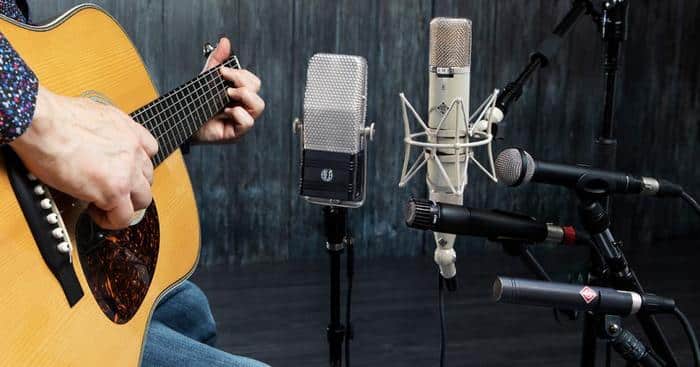
Finding the right microphone is not only crucial for your audio interface for guitar setup, but it’s also an emotionally charged choice that can deeply influence your sound. From my humble beginnings channeling iconic anthems, to crafting the diverse tonal landscapes of my recorded tracks, I’ve come to understand how critical the microphone is. As with a cherished guitar pick, it’s about finding the mic that resonates with your artistic vision.
When selecting a microphone for guitar, a few key factors should take center stage. First, consider the type. Condenser mics capture high-frequency details and are ideal for crisp, clear acoustic guitar, while dynamic mics handle high sound pressure levels, making them perfect for aggressive electric guitar tones. If authenticity of tone is critical, consider a ribbon mic for a more vintage feel.
Remember, the choice of mic can make or break your sound when using an audio interface for guitar. Experiment with different microphones and positions to capture the vibration and tonal nuances of your guitar. This attention to detail is what transforms good recordings into great ones.
Moving forward in our exploration of guitar recording essentials, let’s delve into the realms of software plugins and digital audio workstation (DAW) compatibility, another essential piece of the puzzle in achieving pristine, emotive guitar recordings.
Software Plugins & DAW Compatibility

After exploring some top-notch audio interfaces, let’s delve into a core component of guitar recording essentials – software plugins and DAW compatibility. As a Berklee grad who’s toggled more plugins than frets on a Fender, I understand the impact the right digital tools have on your recording setup.
Guitar plugins provide access to a diverse range of tones and effects, transforming your interface into an empowering sonic playground. Whether you’re emulating vintage tube amps or experimenting with mind-bending effects, guitar plugins take your soundscape beyond the limitations of physical gear. But remember – no matter how expansive this digital archive, your interface needs to be able to handle it.
DAW compatibility needs no less emphasis. A seamlessly-integrated DAW stands as the conductor, commanding your plugins and interface in harmony. Not all interfaces support all DAWs, so confirming compatibility is crucial for avoiding unpleasant surprises post-purchase.
Compatibility doesn’t limit to the technical, it extends to your personal workflow as well. Knowing your preferred DAW and selecting plugins and interfaces that align with it, translates into a smoother musical journey, like the effortless slide on a guitar string. This synergy, tuned through experience and exploration, is pivotal in carving out your unique sound in recording. So let’s move forward to look at some technical considerations for selecting an audio interface.
Technical Considerations when Selecting an Audio Interface
Input/Output Options for Guitarists
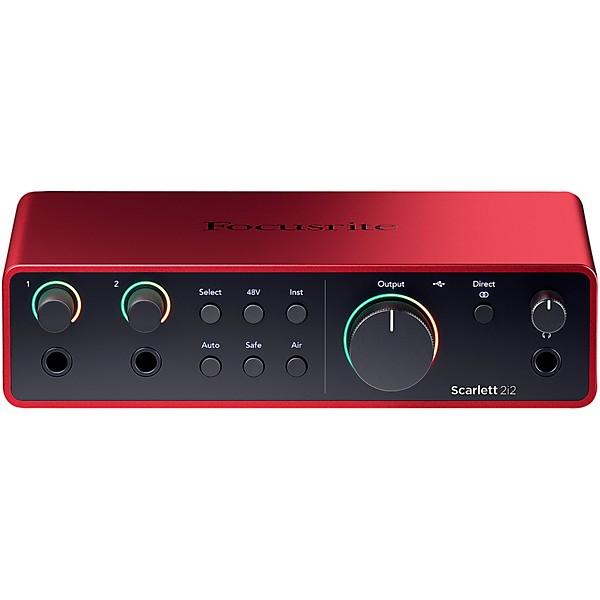
Now let’s zero in on the importance of input/output options for guitarists. I’ve learned from years of recording that these choices can make or break your sound. It’s all about finding harmony in your I/O selections. An audio interface for guitar needs to match your particular recording setup – like a lead guitarist syncing with a drummer’s rhythm.
Consider an interface with multiple input and output options if you’re often playing with a band. You’ll need enough inputs for each instrument and outputs to channel to various studio monitors or headphones. A single input/output option might be enough for your solo home recordings. But versatility is key, and being able to switch things up will give you room to experiment and grow.
Choosing the right I/O options is like connecting the dots – get it right, and your recording sessions will run smoothly, with your tone ringing out clear and true. Look past the price tag and focus on versatility. Trust me – you’ll be glad you did when your sound comes together, just like a well-rehearsed band. So keep your options open, and let’s jam!
Understanding Preamps and Latency Issues
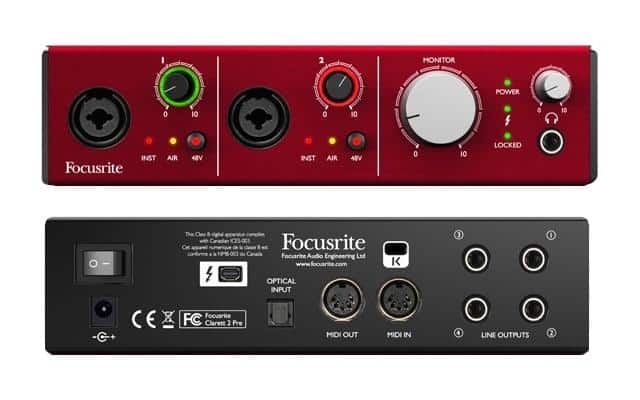
As we venture further into our overview of technical considerations for guitar interfaces, let’s dig into the dynamics of preamps and latency issues – potential pitfalls we need to sour high on our checklist. Having played on the best audio interface of 2024 , I attribute its immense performance to high-quality preamps and minimal latency.
Good preamps ensure the raw guitar signal gets amped up correctly. It should be strong enough to handle the processing without adding unnecessary noise. Thus, the quality of preamps in your audio interface directly reflects on the clarity of your recordings.
Next up: Latency. Put simply, it’s the time delay between your guitar’s output and what you hear back. It’s like getting an echo after your solo. In the world of quick phrasing and rapid solos, even a tiny lag can bring a ‘buzzkill’ moment to your masterpiece. The lower the latency, the better the auditory response time, leading to smooth and real-time playback.
As a seasoned guitarist, I’ve learned that understanding these details can undeniably turn your technical trials into dominating triumphs. Now, with your preamp and latency woes under control, let’s transition to understanding Input / Output options that would suit your specific needs.
FAQs
What is the best audio interface for guitar recording?
Is the Focusrite Scarlett 2i2 suitable for guitar recording?
How about the PreSonus AudioBox for my recording needs?
Is the Universal Audio Apollo Twin MKII worth the investment?
Conclusion
Imagine a world where your music is heard exactly as you envisioned it. After all these strings plucked and notes captured, our journey exploring the best audio interface for guitar draws to an exciting close. Are you ready to take the final step and own the stage that is recording? Your true adventure awaits with your home studio setup for guitarists.
From dissecting the top-rated options like the Focusrite Scarlett Solo and the IK Multimedia AXE I/O, to considering budget-friendly choices such as the Behringer U-Phoria UMC22, we’ve journeyed through the thick of the interface jungle. We’ve broken down the fundamentals, dissected technical aspects such as preamps, latency issues, and input/output options, and illuminated the pathway to your ideal computer recording guitar setup.
Like the last chord that resonates after a power ballad, my final advice to you? Don’t get overwhelmed. You now have the information to consider your needs and budget, align them with the right audio interface, and kickstart your recording journey. Grab your axe, brave the interface wilderness with renewed confidence, and let your music do the talking. Your dream of a professional audio interface for guitarists is now a tangible reality. Rock on and record on, my friends!
